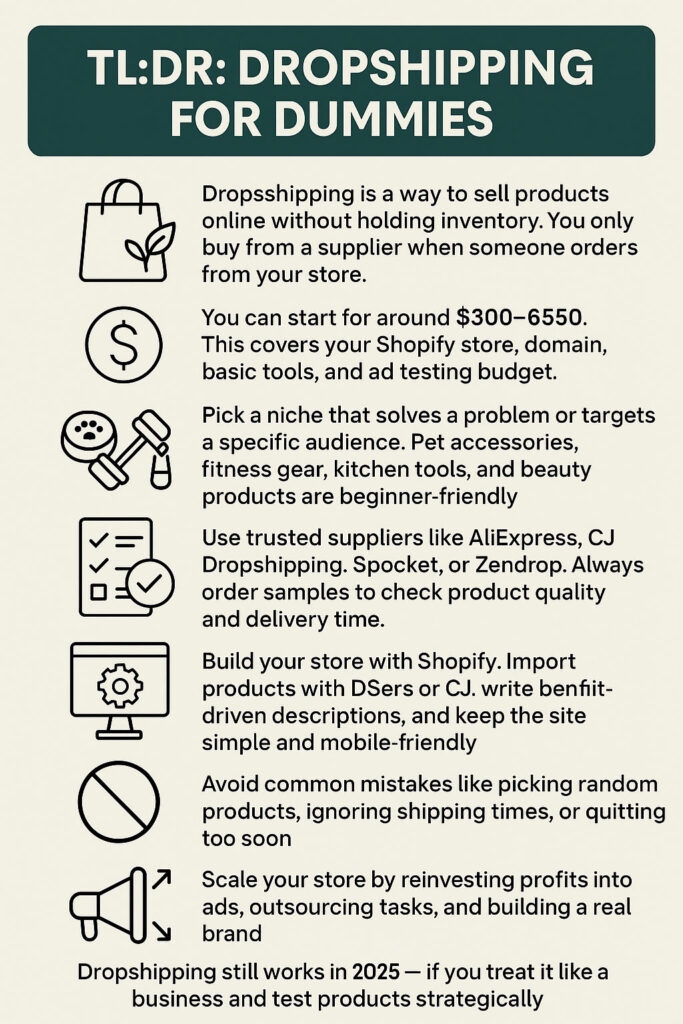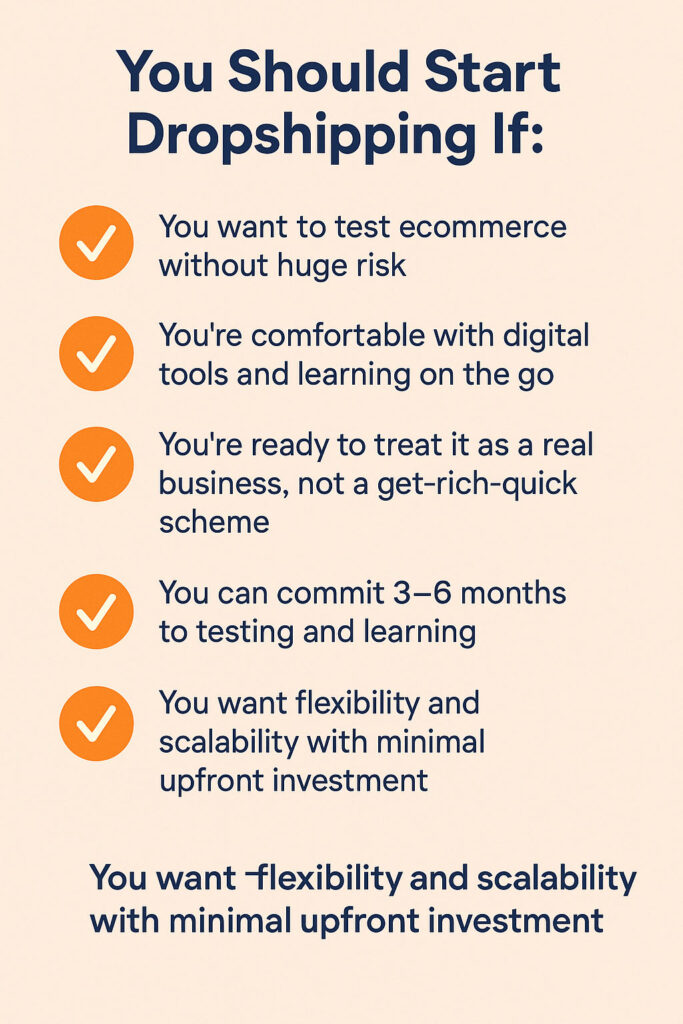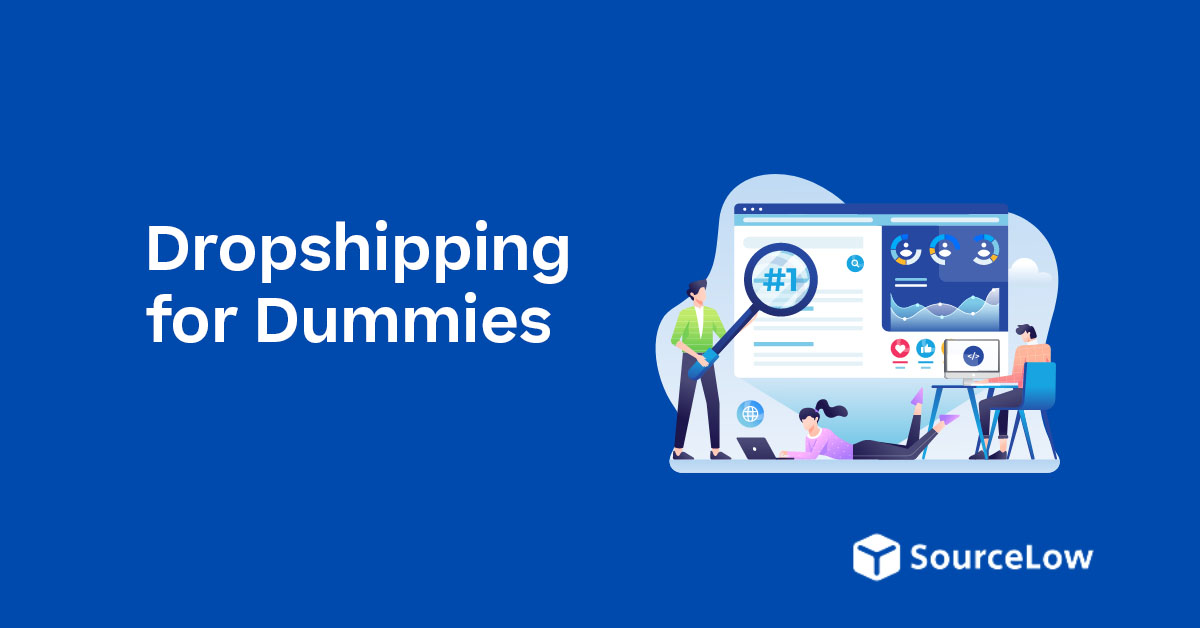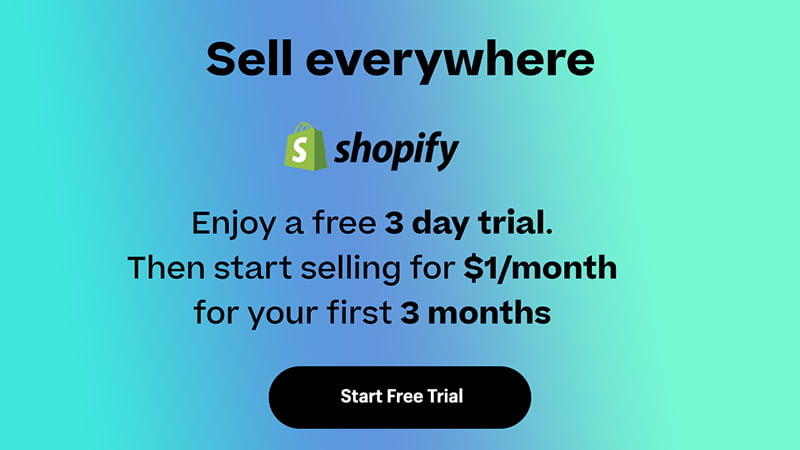Disclosure: We may earn a commission or fee from some of the links in our content. However, this does not affect our recommendations. Learn more.
Dropshipping sounds simple: you sell products without holding inventory. But if you’re brand new, you’ve probably got a lot of questions.
Where do you begin? Which tools do you need? How much does it cost? Can you actually make money?
This beginner guide to dropshipping for dummies answers everything — step-by-step. Whether you want to launch a side hustle or build a long-term online store, this guide is designed to help you start smart and avoid common mistakes.

TL;DR: Dropshipping for Dummies
- Dropshipping is a way to sell products online without holding inventory. You only buy from a supplier when someone orders from your store.
- You can start for around $300–$650. This covers your Shopify store, domain, basic tools, and ad testing budget.
- Pick a niche that solves a problem or targets a specific audience. Pet accessories, fitness gear, kitchen tools, and beauty products are beginner-friendly.
- Use trusted suppliers like AliExpress, CJ Dropshipping, Spocket, or Zendrop. Always order samples to check product quality and delivery time.
- Build your store with Shopify. Import products with DSers or CJ, write benefit-driven descriptions, and keep the site simple and mobile-friendly.
- Drive traffic using TikTok, Facebook, or Google Ads. Organic content like short videos can also bring in sales without spending money upfront.
- Avoid common mistakes like picking random products, ignoring shipping times, or quitting too soon.
- Scale your store by reinvesting profits into ads, outsourcing tasks, and building a real brand.
- Dropshipping still works in 2025 — if you treat it like a business and test products strategically.
Want the full step-by-step breakdown? Let’s get into it 👇
What is Dropshipping and How Does it Work?
Dropshipping is a business model where you sell products online without holding or managing inventory.
When someone buys from your online store, you forward the order to a third-party supplier, who ships it directly to your customer.
You act as the middleman. You earn the difference between your selling price and the supplier’s cost.
Here’s how a dropshipping sale works:
| Step | Description |
|---|---|
| 1. Customer buys from your store | You set the price (e.g. $40) and collect the payment |
| 2. You send the order to your supplier | You pay the supplier’s price (e.g. $15) |
| 3. Supplier ships directly to the customer | You keep the profit ($25 before ad costs) |
The key benefit is you don’t need to buy stock in advance or rent a warehouse. But you also give up some control over shipping times and product quality.
Is Dropshipping Legit or a Scam?
Dropshipping is a real business model used by major retailers like Wayfair and Home Depot, but it’s often misunderstood. The reason is that many people sell low-quality products or overpromise on delivery.
When done correctly, dropshipping can be both legal and profitable. The key is choosing reliable suppliers, setting clear expectations with customers, and offering real value — not just selling cheap junk with long shipping times.
Here’s what dropshipping is not:
- It’s not a get-rich-quick scheme
- It’s not passive income from day one
- It’s not free to start (expect to spend a few hundred dollars)
Done well, though, it’s a low-risk way to start an online store.
How Much Does Dropshipping Cost to Start?
While dropshipping eliminates the need to buy stock upfront, it’s not completely free to get started.
Beginners should be prepared to invest some capital into setting up their store, creating a brand identity, and testing traffic sources.
The exact amount varies depending on the tools and platforms you choose, but a realistic starting budget is between $300 and $650.
Here’s a breakdown of the typical startup costs for a beginner-friendly dropshipping business:
| Item | Estimated Cost |
|---|---|
| Shopify Store (1 month) | $39 |
| Domain Name | $10–$15/year |
| Product Importing App (e.g., DSers) | Free plan available |
| Basic Logo/Design (Canva or Fiverr) | $0–$50 |
| Paid Ads (Testing Budget) | $200–$500 |
| Misc. Tools (email, analytics) | $0–$50 |
Total: $300–$650
The biggest cost is usually advertising. Paid ads on platforms like Facebook or TikTok help you drive traffic to your store and test if your product converts.
Expect to spend at least $20–$50 per day for 3–5 days just to gather enough data to see what’s working.
Without this investment, it’s difficult to get traction, especially if you’re new and have no organic reach yet.
While there are free ways to promote your store using platforms like TikTok, YouTube Shorts, or Pinterest, organic growth usually takes longer and requires more content creation.
Beginners on tight budgets can try this route, but they should understand that it’s a slower path to profitability.
Either way, setting clear financial expectations from the beginning is crucial if you want to avoid burnout or disappointment.
Choosing the Right Niche and Products
Picking the right niche is the foundation of a successful dropshipping store. Most beginners fail because they choose products randomly or follow outdated advice they saw in a YouTube video.
A smart niche should target a passionate group of buyers, solve a specific problem, and offer room to grow. Instead of trying to appeal to everyone, focus on products that cater to specific hobbies, problems, or lifestyles.
Here are some of the top-performing niches for 2025:
- Pet accessories (e.g., dog toys, cat grooming kits)
- Home fitness tools (e.g., resistance bands, massage guns)
- Kitchen gadgets (e.g., vegetable slicers, spice racks)
- Car cleaning supplies (e.g., vacuum attachments, dashboard wipes)
- Skincare and beauty (e.g., facial rollers, LED masks)
Equally important is knowing what to avoid. Some products may seem like a good idea on paper but are more trouble than they’re worth.
These often include electronics (which have high return rates), copyrighted products (which can get you sued), and cheap impulse buys (which don’t leave room for profit after ads).
Avoid these product types:
- Electronics (high refund risk)
- Copyrighted or trademarked items
- Anything under $5 (profit margins disappear after fees)
- Products available on Amazon Prime with faster shipping
The best product isn’t just trendy — it checks the boxes below:
- Solves a real problem
- Has a wow factor or uniqueness
- Costs between $10–$30 from the supplier
- Can sell for $30–$80 with decent margin
Take your time choosing your first product. Use tools like Minea, PPSpy, or Ecomhunt to see what’s trending in real-time. And don’t be afraid to test multiple ideas before settling on one that sticks.
Finding Reliable Dropshipping Suppliers
Your supplier isn’t just a middleman — they’re a core part of your business. A reliable supplier ensures smooth fulfillment, reasonable shipping times, and consistent product quality.
A bad one can lead to refund requests, negative reviews, and even payment gateway suspensions. That’s why sourcing from trusted suppliers is critical, especially in your early stages.
At SourceLow, we manually research and verify suppliers based on their reputation, pricing, shipping policies, and integration features.
We strongly recommend working with platforms that connect directly to Shopify or WooCommerce and offer automation tools. This helps reduce human error and allows you to scale with ease.
Top beginner-friendly suppliers:
- AliExpress – Massive catalog, flexible pricing, but longer shipping times
- CJ Dropshipping – Offers branding, US warehouses, and strong support
- Zendrop – Clean interface and fast fulfillment options
- Spocket – Prioritizes US/EU suppliers with quicker delivery
- SourceLow Vetted Suppliers – All suppliers we list are reviewed based on data, pricing, and feedback
Here’s a quick comparison to help you decide:
| Supplier | Shipping Speed | Location Options | Automation | Best For |
|---|---|---|---|---|
| AliExpress | Slow (14–45 days) | China/Global | Yes | Budget testing |
| CJ Dropshipping | Medium (7–15 days) | US, EU, China | Yes | Branding and scale |
| Zendrop | Fast (3–8 days with upgrade) | US, Global | Yes | User experience |
| Spocket | Fast (2–7 days) | US/EU | Yes | Local suppliers |
Always order a sample before going live with a new product. This gives you a chance to check packaging, quality, and actual delivery times. First impressions matter — especially when you’re building a new brand.
Building Your Store: Tools and Setup
Building a dropshipping store today doesn’t require technical skills or coding knowledge.
Thanks to beginner-friendly platforms like Shopify, you can launch a fully functional ecommerce site in less than a weekend.
Most of the work involves setting up your product pages, customizing your design, and connecting apps to automate orders.
Why we recommend Shopify:
- It’s easy to use, even for complete beginners
- It integrates with apps like DSers, CJ Dropshipping, and Zendrop
- It comes with secure checkout, mobile optimization, and hosting
- You can choose from free and premium themes designed for conversions
Basic Setup Checklist:
- Choose a niche and buy a domain name (e.g., catnest.com for pet beds)
- Sign up for Shopify ($39/month basic plan)
- Pick a theme (try Debutify or Refresh for a clean layout)
- Import products using DSers, Zendrop, or CJ
- Write product descriptions focusing on benefits over features
- Add legal pages (Refund, Privacy Policy, Terms & Conditions)
- Set up payment gateways, taxes, and basic shipping rules
This initial build can be done in 1–3 days. Keep your site simple and clean. Avoid clutter, popups, or spammy countdown timers — they often hurt trust more than they help.
Focus on branding, clear calls to action, and fast load speed. Tools like PageSpeed Insights or TinyPNG can help optimize your images and performance.
How to Market Your Store
Marketing is where most beginners struggle — not because it’s hard, but because they expect instant results. With so many tools and platforms out there, it’s easy to get overwhelmed. The key is to start small, test one strategy at a time, and double down on what works.
Paid Marketing Options:
- Facebook Ads: Still a solid platform for targeting older audiences
- TikTok Ads: Best for visual, impulse-buy products
- Google Shopping: Ideal for evergreen or problem-solving items
Start with $20–$50/day. Create multiple ad creatives and test them against each other. Don’t blow your budget on a single idea — the goal is to find a “winning ad” and scale it once proven.
Organic Marketing Tips:
- Post short-form content on TikTok, Reels, and Shorts
- Use trending sounds and popular hashtags to get reach
- Offer giveaways to grow email lists and followers
- Start a blog using SEO tools to target low-competition keywords
Organic marketing takes longer, but it’s free and builds trust over time. Many stores combine both approaches — using ads to drive traffic and content to build a brand long-term.
Here’s a simple comparison:
| Traffic Source | Cost | Time to Results | Ideal For |
|---|---|---|---|
| Facebook Ads | High | Fast | Beginners with budget |
| TikTok Organic | Free | Slow to Medium | Creative sellers |
| SEO Blog | Free | Slow | Long-term traffic |
| Influencer Collabs | Medium | Fast | Viral/visual products |
Common Mistakes Beginners Make
There’s a reason why 80–90% of beginner dropshipping stores don’t last past the first few months — they make the same avoidable mistakes.
The good news? You don’t have to repeat them. Knowing what to expect and planning ahead can give you a serious advantage.
Top mistakes to avoid:
- Choosing a product just because it’s trending — test before scaling
- Ignoring delivery times — long shipping can kill customer trust
- Overdesigning your store — clean, simple designs convert better
- Not offering customer support — unanswered emails ruin your brand
- Giving up too soon — most winners are found after testing 5–10 products
Another major issue is poor budgeting. Many beginners spend their entire budget on ads without testing different angles or creatives. You need room to experiment. The first campaign rarely works perfectly, but it teaches you what not to do.
Also, don’t neglect your customers. Add live chat, set up a proper support email, and respond within 24 hours.
You don’t need a full support team to create a strong customer experience — just consistency and clarity.
Remember: even with a great product, poor execution will break your store. But solid execution can make an average product profitable.
Scaling Your Dropshipping Business
Once your store is consistently generating sales and you’ve found a few products that perform well, it’s time to focus on scaling.
Scaling doesn’t just mean spending more on ads — it means building systems that allow your business to grow without burning you out. This is where automation, team building, and diversification come into play.
Start by identifying your top-performing product and duplicating its success. Increase your daily ad budget gradually while keeping a close eye on your return on ad spend (ROAS).
Use tools like Triple Whale, Lifetimely, or Adspy to track campaign performance and find new audiences. Consider testing new creatives weekly to keep ad fatigue low and maintain conversion rates.
Next, look at areas you can outsource. This includes tasks like customer support, order processing, content creation, and even ad management.
Platforms like Upwork, Fiverr, or OnlineJobs.ph are great places to find affordable help. Outsourcing frees up your time to focus on strategy, branding, and expanding product lines.
Consider brand-building strategies to future-proof your store. Private labeling allows you to add custom packaging, logos, and product inserts — giving your business a more premium, trustworthy feel.
Use tools like CJ Dropshipping’s POD service to design your own branded materials. Add upsells, bundles, and email flows using tools like Klaviyo or ReConvert to boost your average order value and customer lifetime value.
Key areas to scale:
- Ad spend on proven campaigns and audiences
- Outsource low-value tasks to focus on high-impact areas
- Private label and brand your best products
- Add upsells, bundles, and email sequences to maximize profit per customer
- Diversify traffic with Google Ads, influencer campaigns, or organic SEO
Dropshipping Case Studies and Results
Success in dropshipping comes from testing, learning, and adjusting based on real-world feedback.
While there are countless “gurus” showing $100,000 dashboards, the most useful insights come from real, grounded case studies that show what actually works — and what doesn’t — for everyday sellers.
One case study comes from a beginner store in the pet niche. Using organic TikTok traffic, the store generated over $8,000 in revenue in under 90 days.
The owner posted 1–2 short videos per day showing their product in use, used trending sounds, and added clear calls to action.
Without running ads, they focused entirely on consistency and storytelling, proving that organic growth is still possible.
Another store that sourced products using Spocket saw a 30% reduction in delivery time compared to using only AliExpress suppliers.
This resulted in fewer refund requests and improved customer satisfaction. Faster delivery helped the brand secure positive reviews and increase repeat customer rate.
Email marketing continues to play a major role in conversion. Shopify found that stores using Klaviyo or similar platforms see 20–25% higher repeat customer conversions through abandoned cart and win-back sequences.
Finally, Zendrop reported that their top sellers consistently test 6–8 products before finding one that scales profitably. The takeaway: testing is not optional — it’s the path to success.
Real-World Data:
| Metric | Insight |
|---|---|
| $8,000 in 3 months | Achieved via TikTok organic (pet niche) |
| 25–40% faster shipping | Spocket vs. AliExpress |
| 20–25% conversion boost | Stores using Klaviyo for email automation |
| 6–8 products | Average tests before finding a winning item |
Should You Start Dropshipping in 2025?
Dropshipping still works — but not in the same way it did five years ago. The market has evolved, and so have customer expectations.
In 2025, dropshipping is less about throwing random products on a website and hoping for the best. It’s about finding real product-market fit, branding well, and executing consistently.
If you’re someone looking for low-risk, low-investment ways to start an ecommerce business, dropshipping is still one of the best paths available.
You don’t need to invest thousands of dollars into inventory, warehouses, or logistics.
With the right setup, you can test ideas quickly, scale what works, and pivot when needed — all from your laptop.
That said, it’s not passive. Dropshipping takes effort, strategy, and a bit of trial and error.
You’ll need to learn paid traffic, customer service, product research, and some basic analytics.
But if you’re willing to learn and stay consistent for 90–180 days, the payoff can be real. Many of today’s biggest ecommerce brands started with simple dropshipping stores.
Ultimately, dropshipping in 2025 is still worth it — if you treat it like a business.
Don’t chase shortcuts. Focus on value, execution, and customer experience. With the tools, suppliers, and automation available today, there has never been a better time to get started.
You should start if:
- You want to test ecommerce without huge risk
- You’re comfortable with digital tools and learning on the go
- You’re ready to treat it as a real business, not a get-rich-quick scheme
- You can commit 3–6 months to testing and learning
- You want flexibility and scalability with minimal upfront investment

Final Thoughts: Dropshipping for Dummies Made Simple
Dropshipping can be the perfect entry point for ecommerce beginners. You can launch a store in just a few days, with minimal upfront investment, and start testing ideas quickly.
Just focus on:
- Picking products that solve real problems
- Using reliable suppliers
- Building a clean, trustworthy website
- Testing multiple ads before scaling
This is a business — not a side hustle lottery.
When you’re ready to go deeper, SourceLow has you covered. We’ve done the heavy lifting on supplier research, tool comparisons, and ecommerce advice — all designed to help new sellers like you succeed faster.


